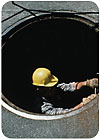
Many articles have been written on the topic of confined space entry since federal OSHA issued the final rule in 1993. However, few have focused on the ugly “back story†of this topic — what alleged violations are cited when major disaster strikes, serious injuries and/or fatalities occur, citations are issued, fines are levied and the matter heads for the courtroom.
This article is intended to assist employers identify those critical aspects of their maintenance operations that may need special emphasis so that their OSHA-compliant Permit-Required Confined Space entry program is free from incident and possible citations. The comments and advice from the author represent precepts gleaned from his participation in more than 25 expert witness cases since 1976 in the confined space area.
Key issues that could possibly lead to contested cases include:
- Application of general industry vs. construction safety standards;
- Classification of spaces (permit/non-permit/etc.);
- Air quality testing;
- Ventilation;
- Permit system/permit content;
- Rescue requirements;
- Training and duties of key personnel.
General Industry vs. Construction
Paragraph (a) of 1910.146 specifically exempts “agriculture construction and shipyard employment†from compliance with the Permit-Required Confined Space rule. For years, the moment a backhoe, “bobcat†or crane was at the job site (or even if the word “construction†was painted on the door of a pick-up truck) employers have often claimed exemption from 1910.146 and, at best, followed bare minimal compliance with CFR1926(b)(6), the confined space rule for construction from the 1970s.Some salient points should be noted here: OSHA has clearly distinguished and classified maintenance, rehabilitation, relining, etc., as general industry tasks while only true building of the space (or major reconstruction) should fall under construction regulation. The CFR1926 construction regulation is limited, and in the absence of a current rigorous confined space rule for true construction work, many large host employers and mega-project managers have required all sub-contractors to follow 1910.146 even though the site was really a bona fide construction site. As a result of some combination of the above circumstances, certain employers failed to follow 1910.146 practices at sewer relining projects, tank entry and wet well pump maintenance operations, with disastrous consequences.
None of the author’s expert witness assignments in the area of General Industry vs. Construction was ever adjudicated in favor of the employers’ contention that 1926.21(b)(6) was the appropriate standard for compliance when basic maintenance of an existing confined space was the task being performed.

Figure 1. Options for entry
Classification of Spaces
CFR1910.146 states in its General Requirement Section (c)(a) that an employer must evaluate work spaces at their facilities for the possible presence of “Permit-Required Confined Spaces†as given in the Definition Section (b) of the regulations. The evaluation of the workspace and the resultant proper classification of the space are best described by the logic path diagram given in Figure 1.When the confined space under review fails the test of “hazard-free†status, it must be designated as “permit-required.†1910.146 allows four options for “permit-required†entry:
- Employee Entry Prohibited (c)(3), (c)(8), (c)(9);
- Permit in Perpetuity (always entered under full permit conditions) (c)(4);
- “Reclassification to Non-Permit†status through elimination of all hazards (c)(7);
- “Alternate Procedure†using adequate ventilation when only atmospheric hazards are present (c)(5)(ii).
- The employer often makes a determination of non-permit status even when ALL HAZARDS have not been eliminated.
- The employer introduces a blower of 1,200 cfm effective capacity to a 1,500 ft3 pit with six inches of standing liquid of unknown origin at the bottom of the pit. In this instance, the blower is of adequate capacity to effectively ventilate the space, but standing liquids of unknown origin cannot be present during “(c)(5) Alternate Procedure†entries.
- The employer combines (c)(5) and (c)(7) procedures to reclassify a space unaware that a federal OSHA opinion letter in the mid-1990s does not allow combining the two procedures (since ventilation never eliminates air contaminates; it can only possibly control them to safe levels.)
- An employer puts workers in protective suits to clean out sludge-like residue at the bottom of a chemical tank after bringing a gasoline powered blower into the tank producing carbon monoxide. The contention of a “(c)(5) Alternate Procedure†due to continuous ventilation was firmly overruled by an administrative law judge due to CO exposure and chemical hazards still in the confined space.
- An employer incorrectly designated furnace shut down, cool down, isolation (with lockout) as “Alternate Procedure†simply because a blower was required after all other hazard removal steps were complete. Only atmospheric hazards (actual or potential) can be present in Alternate Procedure entries, thus the above furnace preparation was essentially a “(c)(7) Hazard Eliminated†entry, not “Alternate Entry.â€
Rescue
Federal OSHA’s only substantive change of 1910.146 since its introduction was in 1998 when it expanded rescue section (k), added employee participation paragraph (l), and introduced Appendix (F) for Evaluation Criteria for Rescue Services. Many employers failed to have the resources to develop their own rescue service and sought help from fire departments or private contract rescue services. Several salient points can be made regarding compliance with the enhanced rescue section (k) and Appendix (F):- Employers have often incorrectly classified the space as a non-permit space at the outset in order to avoid the costly requirements of rescue section (k).
- The employer sometimes argued reclassification of this permit space to non-permit (to avoid costs) when in truth they had not truly eliminated all hazards through isolation of the space.
- Employers have wrongly argued that an attendant activating a non-entry rescue retrieval device while summoning an EMS unit via cell phone is full compliance with rescue section (k) and guidelines of Appendix (F).
- The employer named a local fire department as the off-premises rescue service but had no written contract or on-site practice drills to support their contention.